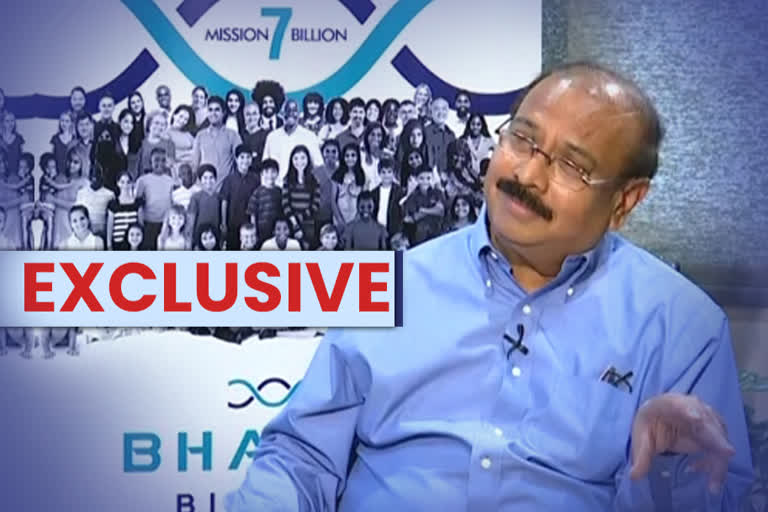Hyderabad: Leading vaccine maker Bharat Biotech announced that it has successfully developed COVAXIN, India's first vaccine candidate for COVID-19. In an exclusive interview with ETV Bharat, Dr Krishna Ella, Chairman and Managing Director of Bharat Biotech speaks about challenges of vaccine development, trials involved and the company's commitment to produce the cheapest COVID-19 vaccine in the world.
Q. There is a race for the vaccine. Will your company be the first to announce a successful vaccine?
A: Usually every vaccine takes 14-15 years to develop. So you want the 14-15 years to compress to one year, it is a challenging task for all of us- for every manufacturer, for every regulator.
And it is happening at the manufacturer's level and regulator's level.
Q. So you have been able to bring it to a short time period. Now that itself is an achievement as such. But is it because of global cooperation? A lot of scientific literature is also available and therefore researchers put it out in the open. Has this of scientific literature helped you?
A: On COVID-19 there was not much literature available 2-3 months back. A lot of data is coming in and I am glad that China, the US are putting it in the public domain. That is a good thing.
But from manufacturers angle, nothing is published. Whatever is published is more of animal data and clinical data. Manufacturing is always a trade secret. So nobody will put it in the public domain.
No manufacturing process is usually filed for patent also. They all keep it as propriety, technical know-how within the company.
Q. Can you tell us how the trial process begins and the stages involved before the vaccine is brought to the market?
A: National Institute of Virology (NIV), Pune isolated the virus. They characterised the virus and that virus is being given to us. Then we manufacture R&D batch and then GMP batch.
The one that goes into the human should be manufactured in Good Manufacturing Practise (GMP) batch. And we have to make three consistency batches, so that batch variations are not there.
After manufacturing three batches, we formulate, fill in the vile and one vile goes to stability and other goes to animal toxicology. Then we do three animal toxicology- mice, rabbit and rat. We give 1-2 doses of vaccine to animals, follow the immunology, toxicology and safety.
After finishing that we get phase-1, 2 clinical formations. In phase 1- the trial is for 28 days and serology analysis is done to recruit a COVID-19 free person.
Once the volunteers are recruited after rt-pcr test, doses are given and on the 28th-day samples are drawn. Then we do serology. The antibodies produced in the body will not allow the virus to multiply. This is called neutralisation.
We bring the blood samples and the virus in BSL-3 lab and that virus should not multiply. After that, we go to phase-2, 3. It is a lengthy process.
Q. How close are we to a vaccine?
A: Definitely a vaccine will be there for sure. We are working on three platforms and we are sure in two platforms it will work for sure. There are hundreds of R&D companies but only a few manufacturing companies with vaccine manufacturing experience.
Q. In India, NITI Aayog has said that there are six candidates who have made it to the list. How is Indian manufacturer looking? What is the ratio between labs and manufacturers in India?
A: In India, most manufacturers are in the vaccine field and R&D companies are very few. They don't have the expertise in quality control and vaccine research.
It is a long process, in the US many are R&D companies. In India, manufacturing companies are also R&D companies. Bharat Biotech is also an R&D company with over 100 scientists currently working.
Q. BSL-3: Is it a set of guidelines? Can you explain what it is?
A: BSL means Bio Safety Level. The lowest category is BSL-1 and BSL-3 is the highest. Similarly, we have BSL labs as well. Bharat Biotech is perhaps the only company with BSL-3 production facility. China recently sanctioned $200 million to build a BSL-3 facility. The US is also going to build one.
We would not have been allowed to manufacture live inactivated vaccine in India if we did not have BSL-3 facility. Without this facility, we cannot manufacture live virus vaccines. We are on the right track.
Q. A lot of manufacturers are using vero cell technology to manufacture inactive viruses. Is Bharat Biotech also using the same platform or has it developed something unique?
